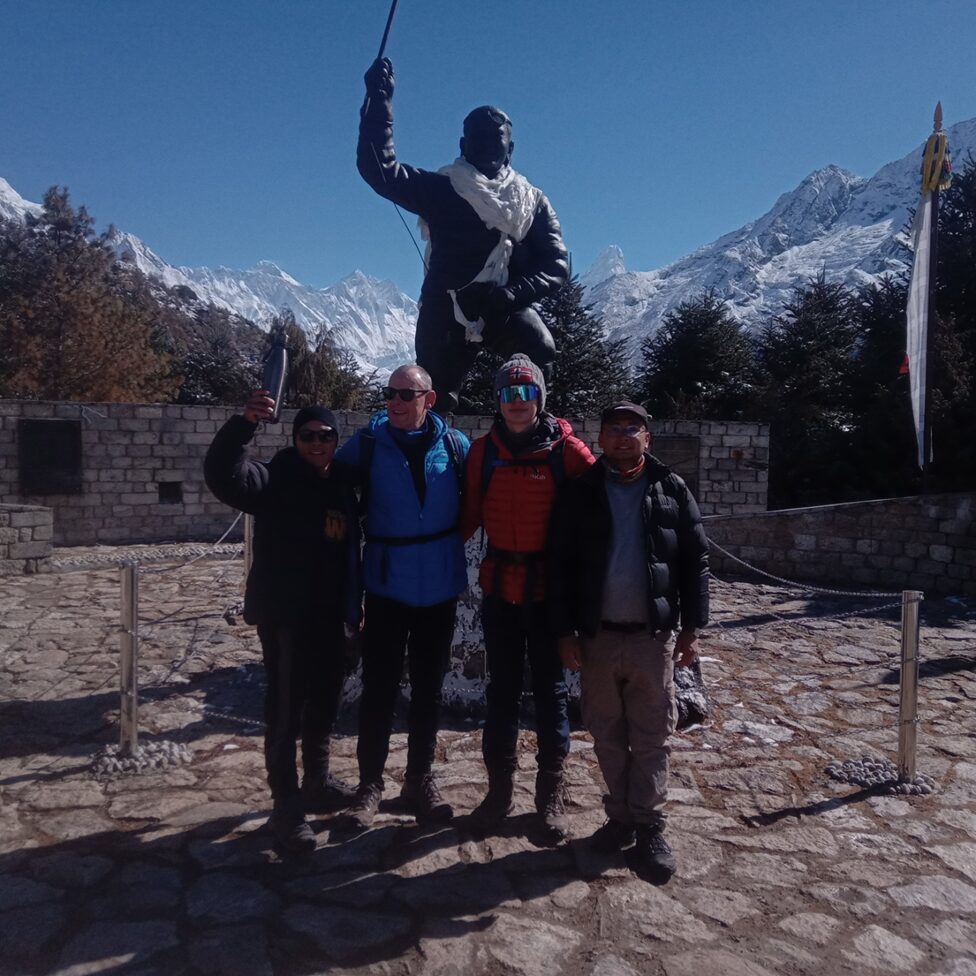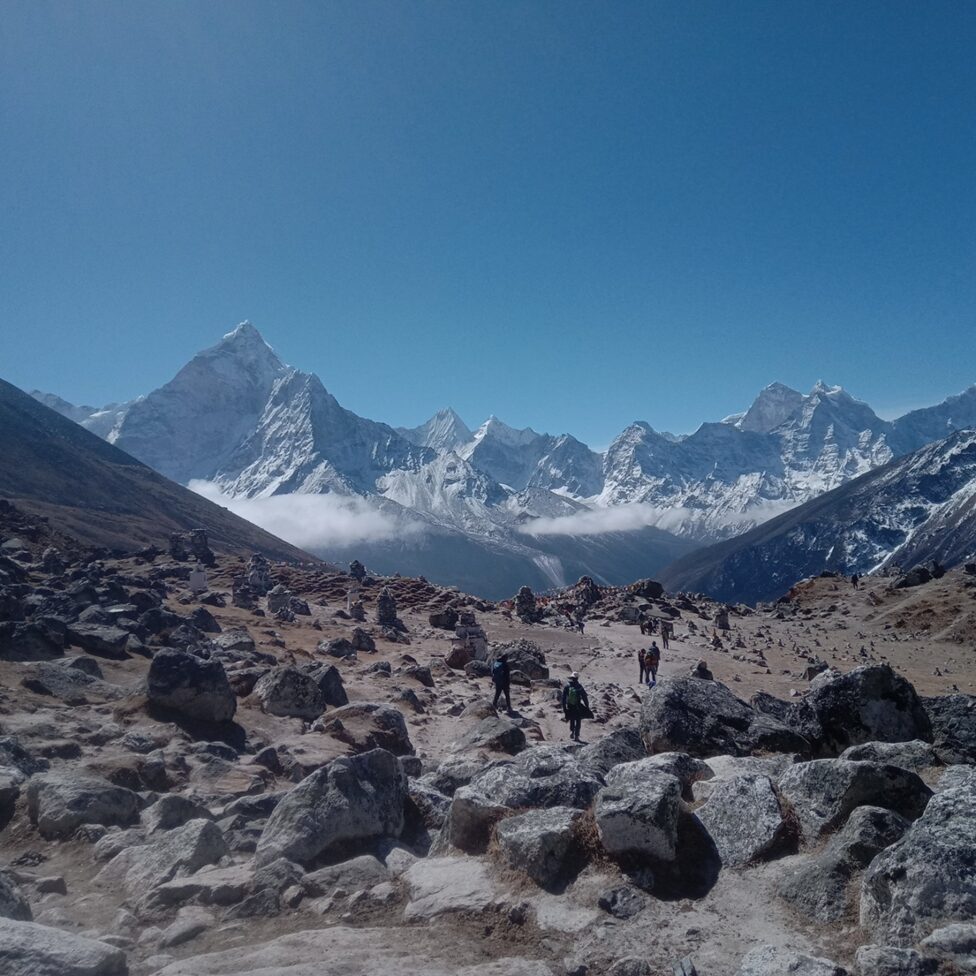The Everest Base Camp trek offers a bucket-list adventure for trekkers worldwide, with costs varying significantly based on the level of service, trek duration, and additional options. On average, a standard trek costs between $1,200 to $2,000 per person for 12–16 days. This typically includes permits, domestic flights, accommodation, meals, a guide, and porters. Budget options might cut costs by reducing services, while luxury packages, which can exceed $4,000, include premium lodging, meals, and additional comforts. The cost also depends on whether trekkers opt for a group tour or a private trek. Travelers should budget extra for personal expenses, gear, tips, and unforeseen costs.
Look and Pick:
When planning your Everest Base Camp trek, consider what aspects of the trip are most important to you. Do you want a more comfortable experience with luxurious amenities, or are you happy with basic accommodations and a more rugged experience? Your preferences will dictate how much you spend, and there’s no one-size-fits-all approach to the trek.
By carefully choosing what services and extras you want, you can tailor your budget and make adjustments as needed. Whether you decide to go for a fully supported package with a guide, porter, and pre-arranged accommodation, or prefer to arrange most of the details yourself, understanding the various cost components will help you plan your dream trek without breaking the bank.
Everest Base Camp Trek Cost as per Itineraries 2025/2026
Overview
The Everest Base Camp Trek (EBC) remains one of the most famous experiences for trekking devotees around the world. As the door to the world’s tallest mountain, it guarantees breathtaking scenes, one-of-a-kind social encounters, and a sense of achievement unmatched by most other treks. In any case, understanding the costs included is vital for legitimate arranging. This comprehensive direct breakdown of the Everest Base Camp trek fetched as per the agendas for 2025/2026, covering each viewpoint from licenses to Luxury add-ons, guaranteeing you can budget successfully for your Himalayan trek.
EBC Trek Costs
The fetch of the Everest Base Camp trek changes altogether depending on the schedule, administrations included, and the level of consolation you look for. On normal, you can anticipate the trek to take a toll anywhere from $1,200 to $4,000 per individual. The lower run regularly covers essential bundles advertised by neighborhood trekking offices, whereas the higher run incorporates Luxury bundles with helicopter rides, premium lodges, and personalized administrations. Let’s investigate the key components of these costs in more noteworthy detail.
Sample Itineraries and Their Costs
12-Day Standard Itinerary:
- Includes: Lukla flights, permits, guide and porter, teahouse accommodation, and meals.
- Cost: $1,200 to $1,800 per person.
14-Day Mid-Range Itinerary:
- Includes: Lukla flights, permits, guide and porter, mid-range lodges, and meals.
- Cost: $1,800 to $2,500 per person.
Luxury Itinerary with Helicopter Return:
- Includes: Helicopter to Lukla, luxury lodges, guide and porter, meals, and helicopter return from Gorak Shep.
- Cost: $4,000 to $5,000 per person.
Seasonal Cost Variations
The toll of the Everest Base Camp trek shifts by season, with peak trekking seasons (spring and autumn) being more costly due to higher requests. Amid these times, flights, settlements, and direct administrations regularly took a toll. Low-season trekking (monsoon and winter) is cheaper, but climate conditions can be challenging, and fewer administrations may be accessible.
Trek to Everest Base Camp Cost – 14 Days
Overview
A 14-day Everest Base Camp trek is among the most popular options, with costs ranging from $1,200 to $2,500 per person. The price includes permits (Sagarmatha National Park and TIMS), round-trip domestic flights between Kathmandu and Lukla, tea house accommodations, three meals a day, and professional guide and porter services. Budget packages may compromise comfort, while mid-range options strike a balance between affordability and quality. Additional costs to consider include gear rental, travel insurance, and tips for guides and porters. This itinerary is ideal for trekkers with limited time, offering an immersive yet efficient experience in the Himalayas.
Tips for Reducing Costs
- Travel Off-Season: Trekking during off-peak seasons like winter (December to February) or monsoon (June to August) can reduce accommodation and flight costs, but prepare for harsher weather conditions.
- Join Group Treks: Joining a group trek through a trekking agency can lower individual costs by sharing guide and porter services.
- DIY Trekking: If you’re an experienced trekker, planning the trek independently and skipping guided services can save money. However, this requires thorough preparation.
- Pack Smart: Bringing your own snacks, water purification tablets, and essential medicines can reduce dependency on higher-priced items along the trail.
- Negotiate: Don’t hesitate to bargain for better rates on accommodations and services, especially during less crowded seasons.
Itinerary
Day 1: Entry in Kathmandu.
Day 2: Flight to Lukla and trek to Phakding.
Day 3: trek to Namche Bazaar.
Day 4: Acclimatization day in Namche Bazaar.
Day 5: trek to Tengboche.
Day 6: trek to Dingboche.
Day 7: Acclimatization day in Dingboche.
Day 8: trek to Lobuche.
Day 9: trek to Gorak Shep and Tour Everest Base Camp.
Day 10: Climb to Kala Patthar and trek back to Pheriche.
Day 11: trek to Namche Bazaar.
Day 12: trek to Lukla.
Day 13: Flight back to Kathmandu.
Day 14: Departure.
Best Time to Trek
The best time to trek to Everest Base Camp is amid the pre-monsoon (spring) and post-monsoon (harvest time) seasons. The spring season, from March to May, offers clear skies, blooming rhododendrons, and direct temperatures, making it one of the most well-known times for trekking. Autumn time, from late September to November, is similarly engaging with its steady climate, crystal-clear seas of the mountains, and dynamic celebrations like Dashain and Tihar. Winter treks (December to February) are less swarmed and offer staggering snow-covered scenes, but the cold temperatures can be challenging. The rainstorm season (June to August) is, by and large, dodged due to overwhelming precipitation, leeches, and constrained permeability, although it’s a great time for botanists to investigate the rich greenery.
Everest Trek Helicopter Return Cost – 11 Days
Overview
The Everest Base Camp trek with a helicopter return offers a condensed yet luxurious option for adventurers. Costs for this 11-day itinerary typically range from $3,500 to $5,500. The trek follows the classic route to EBC, ensuring trekkers experience iconic stops like Namche Bazaar, Tengboche, and Gorakshep. After reaching base camp, a helicopter ride returns trekkers to Kathmandu, saving time and offering breathtaking aerial views of the Himalayas. This package usually includes permits, meals, accommodations, and guide services, along with the helicopter transfer. While more expensive, it’s a perfect choice for those seeking both adventure and comfort within a limited timeframe.
Why Choose the Helicopter Return Option?
- Time Efficiency: Save 3-4 days of walking by flying back from Gorak Shep to Lukla.
- Comfort: Avoid the challenging descent and enjoy a luxurious return.
- Scenic Experience: The helicopter ride offers unmatched aerial views of the Himalayas.
Itinerary
Day 1: Entry in Kathmandu.
Day 2: Flight to Lukla and trek to Phakding.
Day 3: trek to Namche Bazaar.
Day 4: Acclimatization day in Namche Bazaar.
Day 5: trek to Tengboche.
Day 6: trek to Dingboche.
Day 7: trek to Lobuche.
Day 8: trek to Gorak Shep and Tour Everest Base Camp.
Day 9: Helicopter flight back to Kathmandu.
Day 10: Investigate Kathmandu.
Day 11: Departure.
Tips for a Successful Trek
- Acclimatize Properly: Follow the itinerary and avoid rapid ascents to prevent altitude sickness.
- Pack Smart: Bring essentials such as warm clothing, trekking poles, and a good sleeping bag.
- Stay Hydrated: Drink plenty of water to combat the effects of high altitude.
- Respect Local Culture: Be mindful of Sherpa customs and traditions.
- Get Insurance: Ensure your policy covers helicopter evacuation and high-altitude trekking
Highlights of the Everest Helicopter Return Trek 11-Day:
Scenic flight from Kathmandu to Lukla.
Trekking through Namche Bazaar, Tengboche, Dingboche, and Gorak Shep.
Witnessing the stunning views of Everest, Lhotse, Nuptse, and Ama Dablam.
Exploring the Everest Base Camp and climbing Kala Patthar for a panoramic view.
Returning to Lukla via a helicopter, bypassing the long descent.
Everest Base Camp Group Travel Cost – 15 Days
Overview
Group treks to Everest Base Camp over 15 days offer a cost-effective and social way to explore the region. Prices typically range from $1,100 to $1,800 per person, depending on the group size and services included. This package often includes permits, domestic flights, shared accommodations in tea houses, and three meals daily. Group treks are ideal for solo travelers or those seeking camaraderie while splitting costs. Guides ensure smooth logistics, while porters handle luggage. This cost-efficient option does not compromise the experience, offering an opportunity to meet like-minded adventurers and enjoy the trek in a supportive environment.
Itinerary
Day 1: Entry in Kathmandu.
Day 2: Flight to Lukla and trek to Phakding.
Day 3: trek to Namche Bazaar.
Day 4: Acclimatization day in Namche Bazaar.
Day 5: trek to Tengboche.
Day 6: trek to Dingboche.
Day 7: Acclimatization day in Dingboche.
Day 8: trek to Lobuche.
Day 9: trek to Gorak Shep and Tour Everest Base Camp.
Day 10: Climb to Kala Patthar and trek back to Pheriche.
Day 11: trek to Namche Bazaar.
Day 12: trek to Lukla.
Day 13: Flight back to Kathmandu.
Day 14: Investigate Kathmandu.
Day 15: Departure.
Group Discounts and Packages
Many trekking agencies offer group discounts. For example:
- Groups of 4-6 people might receive a 5-10% discount.
- Groups of 7 or more can negotiate even lower rates.
Some agencies also offer all-inclusive packages, which cover permits, transportation, accommodation, meals, guides, porters, and even gear rental. These packages typically range from USD 1,200-1,500 per person for a group trek.
Tips for Reducing Costs
- Book in Advance: Early bookings often come with discounts.
- Travel in Off-Season: Costs for flights, accommodation, and guides are lower during the off-season.
- Share Resources: Sharing porter services and rooms reduces individual expenses.
- Bring Essentials: Carry water purification tablets, snacks, and personal gear to avoid buying them at inflated prices on the trail.
Is Group Trekking Worth It?
Group trekking has several advantages:
- Cost Savings: Shared expenses make the trek more affordable.
- Camaraderie: Trekking with like-minded individuals enhances the experience.
- Safety: Traveling in a group ensures added safety in remote areas.
Everest Base Camp Luxury Trek
Overview
The Everest Base Camp luxury trek combines adventure with comfort, catering to trekkers who prefer premium services. Costs start at $3,500 and can go upwards of $5,000. This package includes stays at high-end lodges, gourmet meals, private guides, and often additional acclimatization days for a more relaxed pace. The luxury trek ensures a superior experience, with hot showers, comfortable bedding, and personalized service throughout the trek. Optional helicopter rides can further enhance convenience and offer stunning views. This trek is ideal for those willing to invest in an unparalleled experience, balancing the thrill of the EBC trek with the comforts of modern amenities.
Why Choose the Luxury Trek?
- Comfort at High Altitude:: Trekking at tall heights can be physically demanding. Having a warm, comfortable rest each night essentially progresses the involvement, making a difference when you recoup and get ready for another day’s trek.
- Enhanced Safety: Luxury treks prioritize security with experienced guides, top-notch gear, and way better to get to restorative offices. A few bundles indeed incorporate oxygen barrels and convenient height chambers.
- Time-Saving Options: The incorporation of helicopter rides can spare time and diminish the physical strain, permitting you to center on getting a charge out of the trek or maybe stressing around calculated challenges.
- Exclusive Experience: With littler bunches and high-end administrations, the Luxury trek feels more elite, permitting you to appreciate the Himalayas in peace and protection.
Itinerary
Day 1: Entry in Kathmandu and exchange to a 5-star hotel.
Day 2: Flight to Lukla and trek to Phakding.
Day 3: trek to Namche Bazaar.
Day 4: Acclimatization day in Namche Bazaar.
Day 5: trek to Tengboche.
Day 6: trek to Dingboche.
Day 7: Acclimatization day in Dingboche.
Day 8: trek to Lobuche.
Day 9: trek to Gorak Shep and Tour Everest Base Camp.
Day 10: Climb to Kala Patthar and trek back to Pheriche.
Day 11: trek to Namche Bazaar.
Day 12: trek to Lukla.
Day 13: Flight back to Kathmandu and remain at a Luxury hotel.
Day 14: Departure.
Best Time for the Luxury Everest Base Camp Trek
The best seasons for the Luxury Everest Base Camp trek are:
Spring (March to May): Clear skies, sprouting rhododendrons, and charming temperatures make this a prevalent season.
Autumn (September to November): Fresh climate and steady climate give great trekking conditions with dazzling views.
Winter (December to February) and storm (June to August) treks are less common due to harsher climates, but a few Luxury bundles cater to these seasons for those looking for isolation and one-of-a-kind encounters.
Everest Base Camp Trek by Road Cost – 19 Days
Overview
Embark on an epic 19-day trek to the Everest Base Camp that combines the thrill of trekking with the adventure of a scenic road trip. This unique itinerary allows travelers to experience the rugged beauty of the Himalayas without relying entirely on flights, offering an alternative route that ensures stunning landscapes and cultural immersion. Starting from Kathmandu, the trek begins with a road trip to the charming village of Phaplu, bypassing the need for flights to Lukla. From there, the trek unfolds along the classic Everest Base Camp route, passing through lush rhododendron forests, ancient monasteries, and iconic Sherpa villages like Namche Bazaar and Tengboche.
The road-based approach provides flexibility and adds a layer of adventure to the trek. This trek is perfect for those looking to minimize the risk of flight cancellations due to weather while still enjoying the quintessential Everest trekking experience. Highlights include panoramic views of towering peaks such as Ama Dablam, Lhotse, and the majestic Mount Everest itself. Along the way, trekkers will witness the Sherpa culture, visit spiritual landmarks, and acclimatize gradually, ensuring a safer and more comfortable ascent.
With a blend of road and trail, this 19-day itinerary is an ideal choice for those seeking an extended Himalayan adventure. Comfortable teahouse accommodations, expert guides, and well-paced trekking days make this a rewarding experience for seasoned trekkers and beginners alike.
Itinerary
Day 1: Entry in Kathmandu.
Day 2: Drive to Salleri.
Day 3: trek to Taksindu.
Day 4: trek to Kharikhola.
Day 5: trek to Surke.
Day 6: trek to Phakding.
Day 7: trek to Namche Bazaar.
Day 8: Acclimatization day in Namche Bazaar.
Day 9: trek to Tengboche.
Day 10: trek to Dingboche.
Day 11: Acclimatization day in Dingboche.
Day 12: trek to Lobuche.
Day 13: trek to Gorak Shep and Tour Everest Base Camp.
Day 14: Climb to Kala Patthar and trek back to Pheriche.
Day 15: trek to Namche Bazaar.
Day 16: trek to Lukla.
Day 17: Drive back to Salleri.
Day 18: Drive to Kathmandu.
Day 19: Departure.
Best Time for the Everest Base Camp Trek
Timing is crucial for a successful and enjoyable trek to Everest Base Camp. The weather conditions vary dramatically throughout the year, and the best trekking seasons are:
Spring (March to May):
- Advantages: Clear skies, moderate temperatures, and blooming rhododendrons make spring one of the most picturesque times to trek.
- Conditions: Daytime temperatures range from 10°C to 15°C at lower altitudes, dropping significantly at night.
- Highlights: This season also coincides with pre-monsoon weather, offering stable conditions for trekking.
Autumn (September to November):
- Advantages: Post-monsoon clarity provides stunning views of the mountains and comfortable trekking temperatures.
- Conditions: Temperatures range between 10°C and 20°C in the lower regions.
- Highlights: This is the busiest trekking season due to the consistent weather.
Winter (December to February):
- Advantages: Fewer trekkers mean less crowded trails and the snowy landscapes are magical.
- Challenges: Sub-zero temperatures and potential snowfall make this a demanding choice.
Monsoon (June to August):
- Advantages: The least crowded season and lush greenery in the lower elevations.
- Challenges: Frequent rain, leeches, and muddy trails can be challenging, and views are often obscured by clouds.
Highlights of the Everest Base Camp Trek
- Spectacular Mountain Views:
- Witness breathtaking vistas of Mount Everest (8,848.86 m), Lhotse (8,516 m), Nuptse (7,861 m), Ama Dablam (6,812 m), and other towering peaks.
- Cultural Experience:
- Explore Sherpa villages, monasteries, and vibrant local traditions. Key stops include Namche Bazaar, Tengboche Monastery, and Dingboche.
- Scenic Landscapes:
- From lush green valleys to rugged alpine terrain, the trek showcases diverse ecosystems.
- Adventurous Alternative Route:
- The road trek to Salleri or Phaplu provides a unique perspective of Nepal’s countryside and avoids the flight to Lukla.
- Base Camp Achievement:
- Standing at Everest Base Camp at 5,364 meters is a once-in-a-lifetime accomplishment, offering a sense of immense pride and wonder.
- Kala Patthar Viewpoint:
- Sunrise views from Kala Patthar (5,545 m) are a highlight, providing unparalleled panoramas of Everest and its surrounding peaks.
Private Tour to Everest Cost – 14 Days
Overview
Experience the grandeur of the Everest region on a 14-day private tour tailored for an exclusive and personalized adventure. This itinerary is designed for those who wish to trek at their own pace, avoiding the crowded trails while enjoying the serene beauty of the Himalayas. Starting with a scenic flight to Lukla, this trek immerses travelers in the heart of the Everest region, offering unmatched views and cultural insights.
From Lukla, the trail meanders through picturesque villages like Namche Bazaar, the bustling hub of the region, and Tengboche, home to a famous monastery with breathtaking mountain views. Trekkers will ascend gradually, acclimatizing to the high altitude while marveling at the awe-inspiring vistas of Everest, Lhotse, Nuptse, and Ama Dablam. The trek provides ample opportunities to interact with the warm and hospitable Sherpa people, gaining a deeper appreciation for their traditions and way of life.
A private tour ensures unparalleled flexibility, allowing you to customize your experience to match your preferences. Whether it’s spending more time in a favorite village, adjusting the pace of trekking, or exploring hidden gems off the beaten path, this itinerary prioritizes your comfort and satisfaction. Accommodations in comfortable teahouses and the assistance of experienced guides ensure a hassle-free trek.
Why Choose a Private Tour?
A private tour offers unmatched flexibility and comfort. Here are some reasons to consider it:
- Pace and Privacy: Trek at your speed without group constraints.
- Personalized Attention: Guides focus entirely on your needs.
- Custom Itinerary: Tailor the trip to your interests.
- Enhanced Safety: Dedicated support for emergencies.
Itinerary
Day 1: Entry in Kathmandu.
Day 2: Flight to Lukla and trek to Phakding.
Day 3: trek to Namche Bazaar.
Day 4: Acclimatization day in Namche Bazaar.
Day 5: trek to Tengboche.
Day 6: trek to Dingboche.
Day 7: Acclimatization day in Dingboche.
Day 8: trek to Lobuche.
Day 9: trek to Gorak Shep and Tour Everest Base Camp.
Day 10: Climb to Kala Patthar and trek back to Pheriche.
Day 11: trek to Namche Bazaar.
Day 12: trek to Lukla.
Day 13: Flight back to Kathmandu.
Day 14: Departure.
Factors Influencing the Cost
Several factors can influence the overall cost of a private tour to Everest Base Camp:
- Season: Peak seasons (spring and autumn) tend to be more expensive due to higher demand.
- Group Size: Larger groups may reduce per-person costs.
- Accommodation Preferences: Upgraded lodges and hotels increase costs.
- Customizations: Additional side trips or extended itineraries add to the expenses.
- Service Providers: Prices vary depending on the trekking agency and inclusions.
Tips to Reduce Costs
If you’re looking to make the trek more budget-friendly without compromising safety:
- Travel during the off-season (winter or monsoon).
- Opt for basic tea houses instead of luxury lodges.
- Share a guide and porter with others in your group.
- Bring your snacks and essentials from Kathmandu.
What is Included in the Everest Base Camp Trek Cost
- Domestic flights (Kathmandu-Lukla-Kathmandu) or Road transfers.
- Accommodation in tea houses or lodges.
- All suppers amid the trek.
- Licensed guides and porters.
- Trekking grants (Sagarmatha National Park Permit and TIMS card).
- First-aid unit and security equipment.
- Airport exchanges and Kathmandu lodging remain (in the case included).
Everest Base Camp Grants Cost
Everest Base Camp Permits Cost
Sagarmatha National Park Permit: Around $30.
TIMS Card: Around $20 for bunch trekkers and $40 for free trekkers.
Local Entry Fees: Around $20 in certain ranges like Lukla.
By understanding the costs and agendas for different trekking alternatives, you can select the Everest Base Camp involvement that best suits your needs and budget.
Sagarmatha National Park Entry Permit
The Sagarmatha National Park Passage is obligatory for anybody entering the national Park, which is a UNESCO World Legacy location. The permit costs NPR 3,000 (around USD 25) for remote nationals, barring VAT. For SAARC nationals, the charge is NPR 1,500. Children beneath 10 years of age are absolved from this fee.
This law is imperative for preservation endeavors and guarantees the park’s special biodiversity is protected. You can get it in Kathmandu at the Nepal Tourism Board office or at the section checkpoint in Monjo. Guarantee you carry a passport-sized photo and your visa for this process.
Khumbu Pasang Lhamu Rural Municipality Entrance Permit
Another fundamental record is the Khumbu Pasang Lhamu Rustic Region Entrance permit. This permit costs NPR 2,000 (roughly USD 15) and is appropriate for all trekkers, notwithstanding nationality. Not at all like the Sagarmatha National Park, this cannot be gotten in Kathmandu. You can procure it at Lukla or the Monjo checkpoint.
The permit expense underpins nearby advancement ventures and framework upkeep inside the region. Carrying this record is fundamental, as there are numerous checkpoints along the trekking course where you might require it to appear.
Required Documents
To secure the necessary permits for the trek, you will need:
- A valid passport with at least six months’ validity.
- Passport-sized photos (at least two).
- Copies of your travel insurance policy, which should include coverage for high-altitude trekking and evacuation.
- Completed application forms for permits (these can be filled out at the respective offices).
Ensure all your documents are readily accessible to avoid delays during permit acquisition.
What Permits Are Required For Helicopter Tours To EBC?
If you pick a helicopter tour to EBC instead of trekking, you still require licenses. These incorporate the Sagarmatha National Park Passage permit and the Khumbu Pasang Lhamu Rustic Region Entrance permit. The toll remains the same as for trekkers. Be that as it may, your tour administrator ordinarily orchestrates these grants on your behalf, so affirm this when booking your trip.
Accommodation Cost During Everest Base Camp Trek
Accommodation along the EBC trek basically comprises tea houses, which are fundamental, however comfortable lodgings. The take on a room shifts depending on elevation and season. In lower regions like Lukla or Phakding, a room costs around NPR 500-1,000 (USD 4-8) per night. As you climb, the cost increases, coming to NPR 1,500-3,000 (USD 12-25) at higher heights like Gorakshep.
During Peak trekking seasons (spring and Autumn time), costs may be marginally higher due to demand. Rooms regularly have twin beds, and shared lavatories are standard. A few tea houses offer connected washrooms for an extra cost.
Trekking Tea Houses
Tea houses are a necessary portion of the Everest Base Camp trek. They give dinners, settlements, and a warm place to rest after long trekking days. A commonplace menu incorporates dal Bhat (lentil soup with rice), noodles, and soups. Dinners take a toll between NPR 500-1,200 (USD 4-10), depending on the dish and altitude.
Electricity for charging gadgets and Wi-Fi are accessible at most tea houses but come at an additional fee. Charging a gadget can fetch NPR 100-500 (USD 1-4), whereas Wi-Fi gets to ranges from NPR 500-1,000 (USD 4-8) per day.
Breakfast Cost at Everest View Hotel
The Everest View Hotel, found close to Namche Bazaar, is a prevalent halt for trekkers. Known for its staggering views of Everest, it offers an upscale encounter compared to tea houses. An ordinary breakfast here costs around NPR 2,000-3,000 (USD 15-25), which incorporates things like eggs, toast, coffee, and juice. Whereas more costly, the all encompassing sights and extravagant vibe make it worthwhile.
Everest Base Camp Trek Cost: Hiring Guides and Porters
Hiring a direct or guide essentially upgrades your trekking involvement. Guides ordinarily take a toll of USD 30-35 per day, whereas porter charge USD 20-25 per day. A few people combine the parts, serving as “guide-porters” for USD 20-30 per day.
The fetch incorporates their compensation, suppers, and protections. Contracting guides guarantee security, make a difference with routes, and give social experiences.Porter, on the other hand, carry your baggage, permitting you to trek with negligible weight. Tipping is standard, with USD 10-20 per direct and USD 10-15 per Guides considered suitable for their efforts.
What are The Transportation Costs for the Everest Base Camp Trek? Regular Lukla Flight Cost
Flying from Kathmandu to Lukla is the most common way to begin the EBC trek. The toll of a round-trip ticket ranges from USD 180-250 for Nepali nationals and USD 400-500 for remote nationals. Costs change depending on the season and airline.
Flights to Lukla are subject to climate conditions, so delays and cancellations are common. Booking tickets through a solid organization can offer assistance overseeing rescheduling in such cases.
Lukla Flight From Ramechhap Cost
Due to blockage at Kathmandu’s Tribhuvan Worldwide Airplane terminal, numerous flights to Lukla presently operate from Ramechhap. The taken toll remains comparable to flights from Kathmandu, but coming to Ramechhap includes extra costs. A private vehicle to Ramechhap costs around USD 150-180, whereas open buses charge NPR 2500-4,000 per person.
The drive from Kathmandu to Ramechhap takes approximately 4-5 hours, so arrange your travel accordingly.
What is Not Included in Everest Base Camp Trek Cost?
Several costs are not included in standard trekking bundles. These include:
- International flights to and from Nepal.
- Visa expenses for entering Nepal.
- Personal trekking adapts like boots, coats, and backpacks.
- Snacks, drinks, and bottled water were obtained amid the trek.
- Travel protections covering high-altitude trekking and evacuation.
- Tips for guides, porter, and staff.
- Emergency clearing costs (unless secured by insurance).
- Being mindful of these prohibitions makes a difference in dodging unforeseen costs amid the trek.
Visa Cost & Process
Tourists going to Nepal require a visa, which can be obtained on entry at Tribhuvan Worldwide Air Terminal or through Nepalese international safe havens overseas. The visa expense structure is as follows:
USD 30 for a 15-day visa.
USD 50 for a 30-day visa.
USD 125 for a 90-day visa.
You’ll require a visa substantial for at least six months, a passport-sized photo, and the visa expense in cash. Online pre-application is accessible to speed up the handling at the airport.
Flights to Nepal
International flight costs change depending on your area and time of booking. Round-trip tickets from the US to Nepal ordinarily take a toll of USD 800-1,200. Flights from Europe run between USD 600-1,000, whereas those from Asia can be as low as USD 300-600.
Booking tickets well in advance and choosing interfacing flights over coordinated ones can offer assistance and diminish costs. Aircraft like Qatar Aviation routes, Turkish Carriers, and Singapore Aircraft habitually work flights to Nepal.
Tips To Minimize Everest Base Camp Trek Cost
- Travel Off-Season: Trekking during the monsoon or winter season reduces costs as accommodation and flight prices drop.
- Group Trekking: Sharing guides, porters, and other expenses in a group reduces individual costs.
- Book Directly: Avoid intermediaries by booking tea houses and flights directly.
- Carry Snacks: Bringing energy bars and dry fruits reduces spending on expensive snacks.
- Use Refillable Bottles: Avoid buying bottled water by using purification tablets or filters.
Tea House or Camping for Accommodation
Tea houses are the favored alternative for most trekkers due to their comfort and reasonableness. In any case, camping gives a special encounter for those looking for isolation and enterprise. Camping costs more due to the requirement for tents, cooking gear, and staff. On normal, a fully supported camping trek costs USD 3,000-5,000, whereas tea house trekking is altogether cheaper.
By carefully arranging and understanding the costs included, you can make your Everest Base Camp trek both important and budget-friendly.
How to Save Money on the Everest Base Camp Trek
- Book in Advance: Booking your flights, permits, and guides in advance can help you secure better rates.
- Travel in a Group: If you join a group trek, you can split the costs of the guide, porter, and other services, making the trek more affordable.
- Stay in Budget Lodges: Opting for teahouses and basic lodging in the lower altitudes will help you save on accommodation.
- Minimize Extra Expenses: Avoid unnecessary snacks, drinks, and souvenirs. Plan your meals carefully to stick to a reasonable budget.
FAQs Around Everest Base Camp Trek Costs
- How much does the Everest Base Camp trek fetch on average?
The toll ranges from $1,860 to USD 5000, depending on your choices for flights, settlement, guides, and extra services.
- Is it cheaper to book the trek freely or through an agency?
Independent trekking is cheaper but requires more exertion and arranging. Organizations give comfort and security but charge higher fees.
- Are there covered-up costs to be mindful of?
Yes, common covered-up costs incorporate charging gadgets, Wi-Fi, hot showers, and tipping guides and porters.
- Can I trek to Everest Base Camp on a tight budget?
Yes, by trekking freely, traveling in the low season, and minimizing extravagances, you can total the trek for as small as USD 1,860.
- What is the fetch of enlisting a direct and porter?
A direct cost is $30–40 USD per day, and a porter costs $20–30 USD per day.
- How much ought I budget for tips?
It is standard to tip $20–25 USD per day for guides and $15–20 USD per day for porters.
- Are there any options for the Lukla flight?
Yes, you can take transport or jeep to Jiri or Phaplu and trek to Lukla, but this includes 5–7 days to your itinerary.
- Do I require travel protections for the trek?
Yes, comprehensive travel protections covering high-altitude trekking and helicopter clearing are exceedingly recommended.
- Is it fundamental to enlist a guide?
While not obligatory, enlisting a direct improves security, route, and social understanding.
- What is the best time to trek to Everest Base Camp?
The best times are pre-monsoon (March-May) and post-monsoon (September-November) for clear skies and direct climate.
Contact Us Team Himalaya For More Info
Team Himalaya Pvt. Ltd. is a trusted local trekking company based in Kathmandu, Nepal. We specialize in organizing multi-day tours, treks, climbing adventures, expeditions, and other related activities for solo travelers and private groups. Our services extend across Nepal, Bhutan, and Tibet.
For inquiries, feel free to reach out to us at info@teamhimalaya.com or via Whats App at +9779841824281.































